Corrective Control by Line Switching for Relieving Voltage Violations Based on A Three-Stage Methodology
Abstract
:1. Introduction
- (1)
- It can find the “best” line switching scheme to relieve bus voltage violations for the power system.
- (2)
- It can provide a variety of high-quality line switching schemes for multiple-line switching, from which the system operator can select a “desired” one.
- (3)
- It shows fast speed, which means that it is suitable for determining switching lines of large-scale power systems in an online environment.
2. Problem Formulations
3. Solution Methodology
3.1. Stage 1: Screening
3.2. Stage 2: Ranking
3.3. Stage 3: Detailed Analysis and Assessment
4. The Overall Solution Methodology
5. Numerical Schemes
5.1. Single-Line Switching
- Stage 1: By using , 20 effective candidate lines were identified from 45 candidate lines.
- Stage 2: The of each line (20 effective candidates from Stage 1) was calculated to select the top seven lines and rank them in order: lines 26–29, 26–28, 26–27, 2–3, 28–29, 16–21, and 21–22.
- Stage 3: The AC power flow was used to check for any voltage violation at the current operating point with the top seven lines switched out individually. With lines 26–27 and 16–21 switched out individually, we found that there were still voltage violations on bus 26 of 1.0740 p.u. and 1.0497 p.u., respectively. Thus, the high-quality line switching solutions found to relieve voltage violation of bus 26 were lines 28–29,26–29, 26–28, 21–22, and 2–3. With each of these top five lines switched out, the voltage magnitudes on bus 26 were 1.0326 p.u. (NAM = 1.6009), 1.0366 p.u. (NAM = 1.2197), 1.0404 p.u. (NAM = 0.8576), 1.0414 p.u. (NAM = 0.7623), and 1.0416 p.u. (NAM = 0.7433).
5.2. Multiple-Line Switching
5.3. The 2746-Bus System
- Stage 1: There were 79 candidates identified from 2836 candidate lines. Due to space limitations, Table 5 displays 21 effective candidates.
- Stage 2: The 79 candidates were ranked, and the top seven candidates are selected for detailed analysis and assessment to be performed at Stage 3: lines 17–3, 249–3, 474–210, 474–248, 471–210, 249–247, and 374–247.
- Stage 3: For each top candidate line, AC power flow was performed to assess the effectiveness of each candidate. Consequently, lines 17–3, 249–3, and 474–248 were assessed to be most effective for relieving the voltage violation in the power system.
6. Conclusions
Author Contributions
Funding
Acknowledgments
Conflicts of Interest
References
- Song, F.; Wang, Y.; Yan, H.; Zhou, X.; Niu, Z. Increasing the utilization of transmission lines capacity by quasi-dynamic thermal ratings. Energy 2019, 12, 792. [Google Scholar] [CrossRef]
- The, J.; Ooi, C.A.; Cheng, Y.H. Composite reliability evaluation of load demand side management and dynamic thermal rating systems. Energy 2018, 11, 466. [Google Scholar] [CrossRef]
- PJM Manual 03: Transmission Operations, Revision: 54. 2018. Available online: http://www.pjm.com/~/media/documents/manuals/m03.ashx (accessed on 27 March 2019).
- Hedman, W.K.; Oren, S.S.; O’Neil, P.R. A Review of Transmission Switching and Network Topology Optimization. In Proceedings of the IEEE Power and Energy Society General Meeting, Detroit, MI, USA, 24–29 July 2011; pp. 1–7. [Google Scholar]
- Rolim, J.G.; Machado, L.J.B. A study of the use of corrective switching in transmission systems. IEEE Trans. Power Syst. 1999, 14, 336–341. [Google Scholar] [CrossRef]
- Wang, L.; Chiang, H.D. Toward online bus-bar splitting for increasing load margins to static stability limit. IEEE Trans. Power Syst. 2017, 32, 3715–3725. [Google Scholar] [CrossRef]
- Henneaux, P.; Kirschen, D.S. Probabilistic security analysis of optimal transmission switching. IEEE Trans. Power Syst. 2016, 31, 508–517. [Google Scholar] [CrossRef]
- Li, M.; Luh, P.B.; Michel, L.D.; Zhao, Q.; Luo, X. Corrective line switching with security constraints for the base and contingency cases. IEEE Trans. Power Syst. 2008, 23, 125–133. [Google Scholar] [CrossRef]
- Shao, W.; Vittal, V. Corrective switching algorithm for relieving overloads and voltage violations. IEEE Trans. Power Syst. 2005, 20, 1877–1885. [Google Scholar] [CrossRef]
- Shao, W.; Vittal, V. BIP-based OPF for line and bus-bar switching to relieve overloads and voltage violations. In Proceedings of the IEEE Power and Energy Society General Meeting, Atlanta, GA, USA, 29 October–1 November 2006; pp. 2090–2095. [Google Scholar]
- Liu, W.L.; Chiang, H.D. Toward On-Line Line Switching Method for Relieving Overloads in Power Systems. In Proceedings of the IEEE Power and Energy Society General Meeting, Denver, CO, USA, 26–30 July 2015; pp. 1–5. [Google Scholar]
- Mazi, A.A.; Wollenberg, B.F.; Hesse, M.H. Corrective control of power system flows by line and bus-bar switching. IEEE Trans. Power Syst. 1986, 1, 258–264. [Google Scholar] [CrossRef]
- Bacher, R.; Glavitsch, H. Network topology optimization with security constraints. IEEE Trans. Power Syst. 1986, 1, 103–111. [Google Scholar] [CrossRef]
- Khanabadi, M.; Ghasemi, H.; Doostizadeh, M. Optimal transmission switching considering voltage security and N–1 contingency analysis. IEEE Trans. Power Syst. 2013, 28, 542–550. [Google Scholar] [CrossRef]
- Wrubel, J.N.; Rapcienski, P.S.; Lee, K.L.; Gisin, B.S.; Woodzell, G.W. Practical experience with corrective switching algorithm for on-line applications. IEEE Trans. Power Syst. 1996, 11, 415–421. [Google Scholar] [CrossRef]
- Hedman, K.W.; O’Neil, R.P.; Fisher, E.B.; Oren, S.S. Optimal transmission switching-sensitivity analysis and extensions. IEEE Trans. Power Syst. 2008, 23, 1469–1479. [Google Scholar] [CrossRef]
- Hou, L.R.; Chian, H.D. Toward Online Line Switching Method for Reducing Transmission Loss in Power Systems. In Proceedings of the IEEE Power and Energy Society General Meeting, Boston, MA, USA, 17–21 July 2016; pp. 1–5. [Google Scholar]
- Hedman, K.W.; O’Neil, R.P.; Fisher, E.B.; Oren, S.S. Optimal transmission switching with contingency analysis. IEEE Trans. Power Syst. 2009, 24, 1577–1578. [Google Scholar] [CrossRef]
- Escobedo, A.R.; Moreno-Centeno, E.; Hedman, K.W. Topology control for load shed recovery. IEEE Trans. Power Syst. 2014, 29, 908–916. [Google Scholar] [CrossRef]
- Fisher, E.B.; O’Neil, R.P.; Ferris, M.C. Optimal transmission switching. IEEE Trans. Power Syst. 2008, 23, 1346–1355. [Google Scholar] [CrossRef]
- Mak, T.W.K.; Hentenryck, P.V.; Hiskens, I.A. A Nonlinear Optimization Model for Transient Stable Line Switching. In Proceedings of the American Control Conference (ACC), Seattle, WA, USA, 24–26 May 2017; pp. 2085–2092. [Google Scholar]
- Sahraei-Ardakani, M.; Li, X.; Balasubramanian, P.; Hedman, K.W.; Abdi-Khorsand, M. Real-time contingency analysis with transmission switching on real power system data. IEEE Trans. Power Syst. 2016, 31, 2501–2502. [Google Scholar] [CrossRef]
- Khodaei, A.; Shahidehpour, M. Transmission switching in security-constrained unit commitment. IEEE Trans. Power Syst. 2010, 24, 1937–1945. [Google Scholar] [CrossRef]
- Li, C.; Chiang, H.D.; Du, Z. Investigation of an effective strategy for computing small-signal security margins. IEEE Trans. Power Syst. 2018, 33, 5437–5445. [Google Scholar] [CrossRef]
- Wang, L.; Chiang, H.D. Toward online line switching for increasing load margins to static stability limit. IEEE Trans. Power Syst. 2015, 31, 1744–1751. [Google Scholar] [CrossRef]
- Liu, C.; Wang, J.; Ostrowski, J. Static switching security in multi-period transmission switching. IEEE Trans. Power Syst. 2012, 27, 1850–1858. [Google Scholar] [CrossRef]
- Guo, W.M.; Wei, Q.; Liu, G.J.; Yang, M.; Zhang, X.K. Transmission Switching to Relieve Voltage Violations in Low Load Period. In Proceedings of the IEEE Region, Lyngby, Denmark, 6–9 October 2013; pp. 1–4. [Google Scholar]
- Shao, W.; Vittal, V. A New Algorithm for Relieving Overloads and Voltage Violations by Transmission Line and Bus-Bar Switching. In Proceedings of the IEEE PES Power Systems and Exposition, New York, NY, USA, 10–13 October 2004; Volume 1, pp. 322–327. [Google Scholar]
- Fu, B.; Ouyang, C.X.; Li, C.S.; Wang, J.W.; Gui, E. An improved mixed integer linear programming approach based on symmetry diminishing for unit commitment of hybrid power system. Energy 2019, 12, 833. [Google Scholar] [CrossRef]
- El-Abiad, A.H.; Stagg, G.W. Automatic evaluation of power system performance-effects of line and transformer outages. AIEE Trans. Power Appar. Syst. 1963, 81, 712–715. [Google Scholar] [CrossRef]
- Chen, M.; Shi, D.; Li, Y.; Zhu, L.; Liu, H. Research on Branches Group Based Method for Adding Mutual Inductance Branches to Y-Matrix and Z-Matrix. In Proceedings of the IEEE PES Power Systems and Exposition, Boston, MA, USA, 17–21 July 2014; pp. 1–5. [Google Scholar]
- Stott, B.; Alsac, O. Fast decoupled load flow. IEEE Trans. Power Appar. Syst. 1974, PAS-93, 859–869. [Google Scholar] [CrossRef]
- Lee, C.Y.; Chen, N. Distribution factors of reactive power flow in transmission line and transformer outage studies. IEEE Trans. Power Syst. 1992, 7, 194–200. [Google Scholar] [CrossRef]



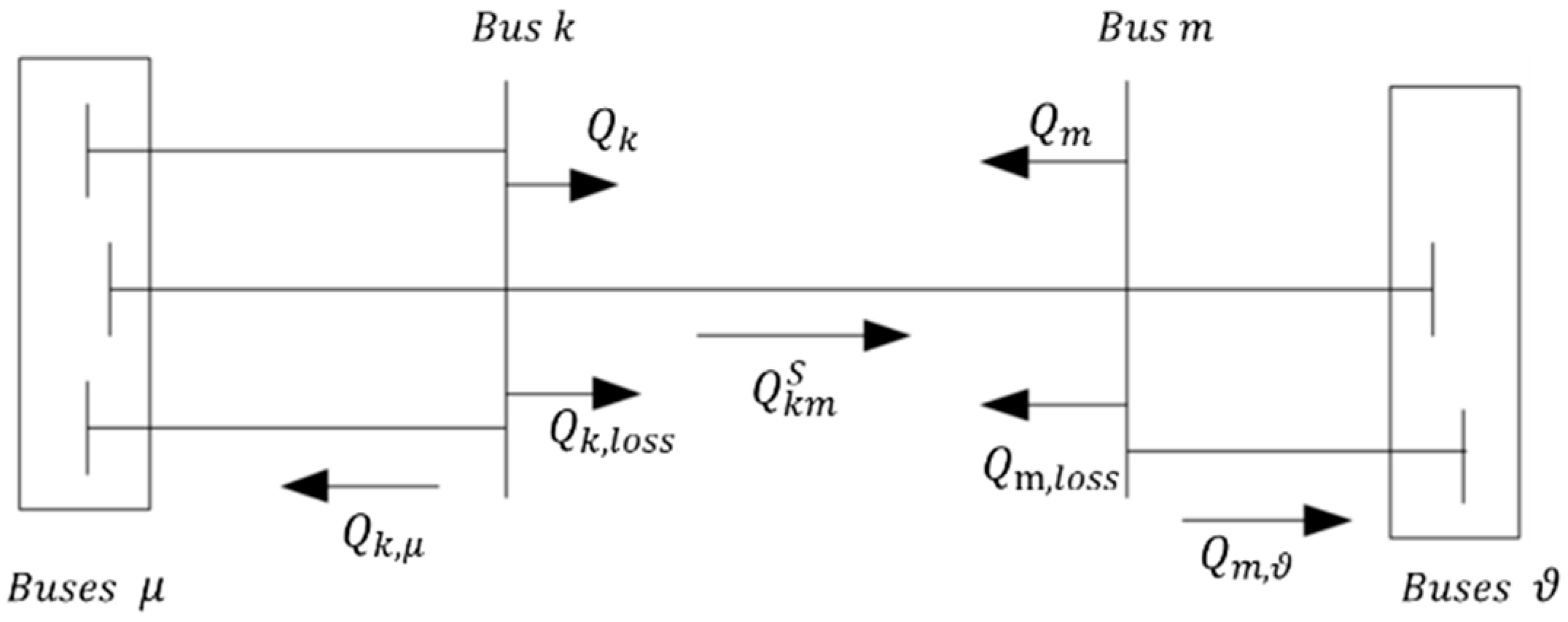
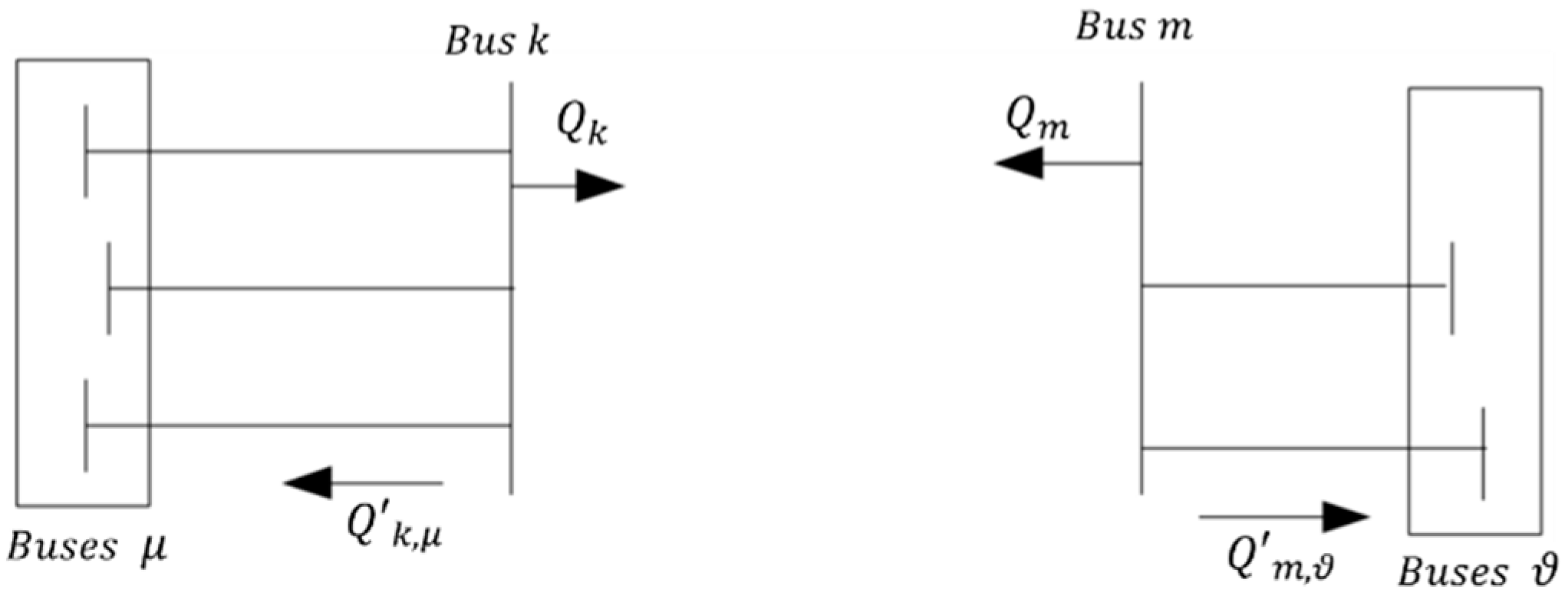

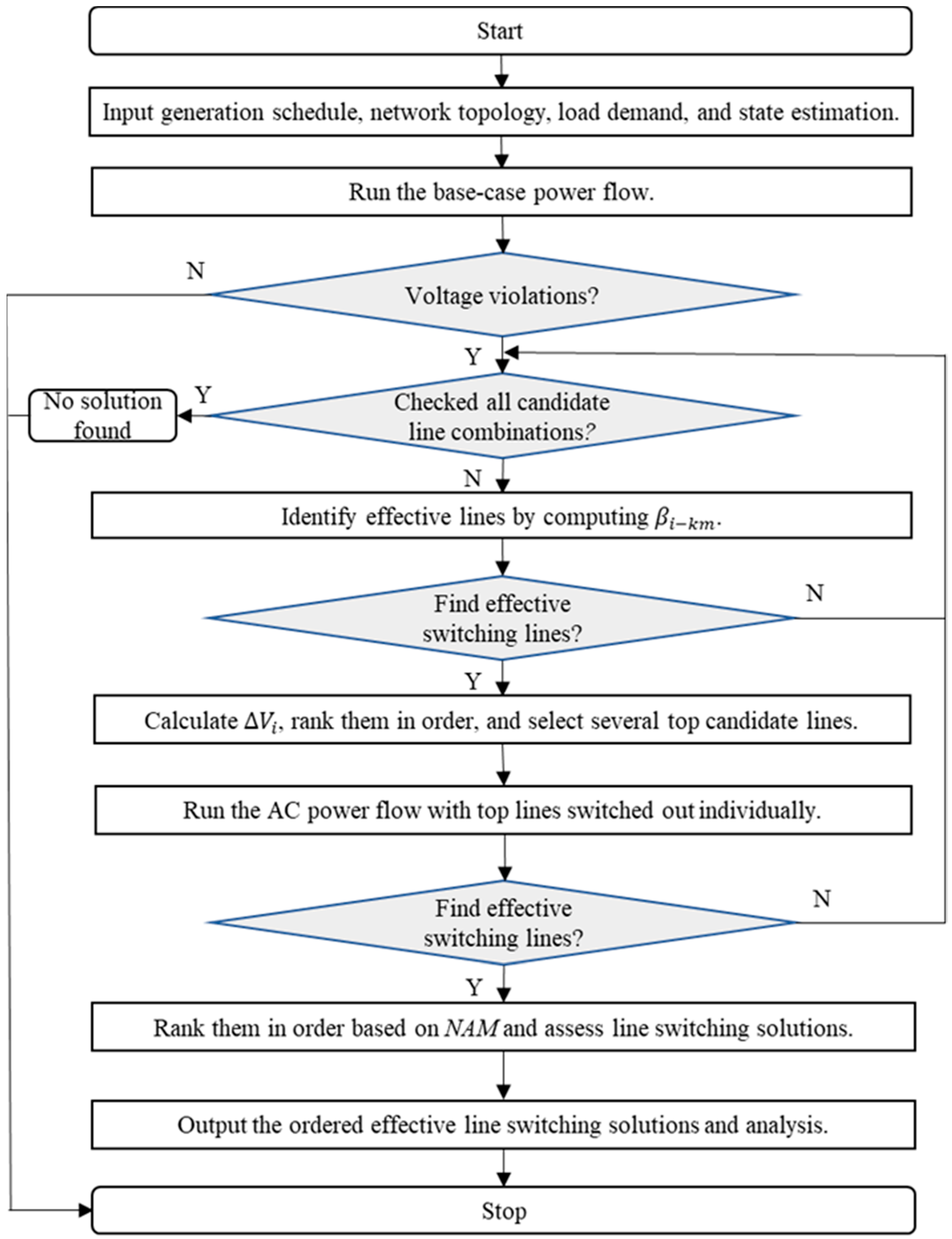
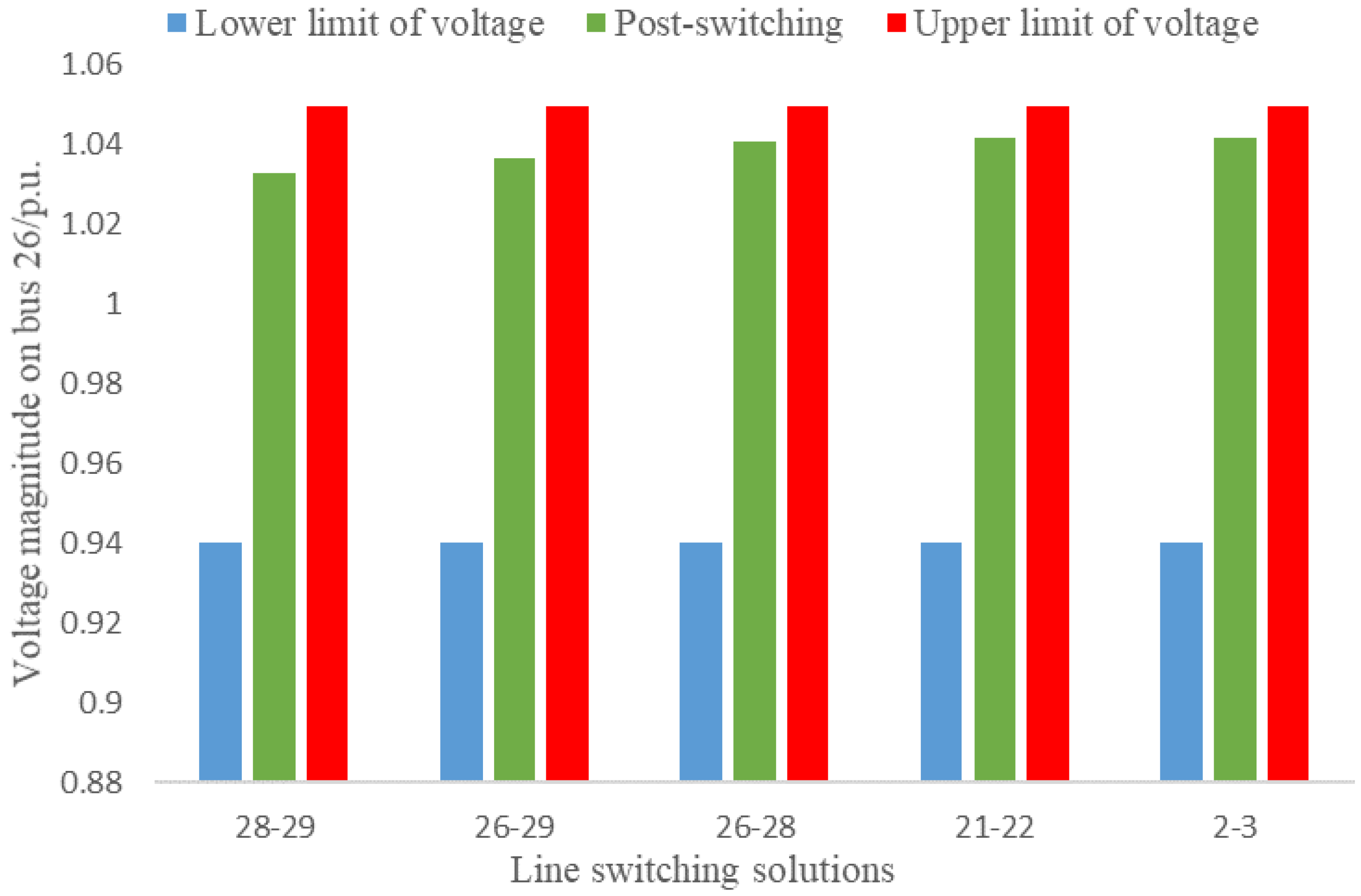
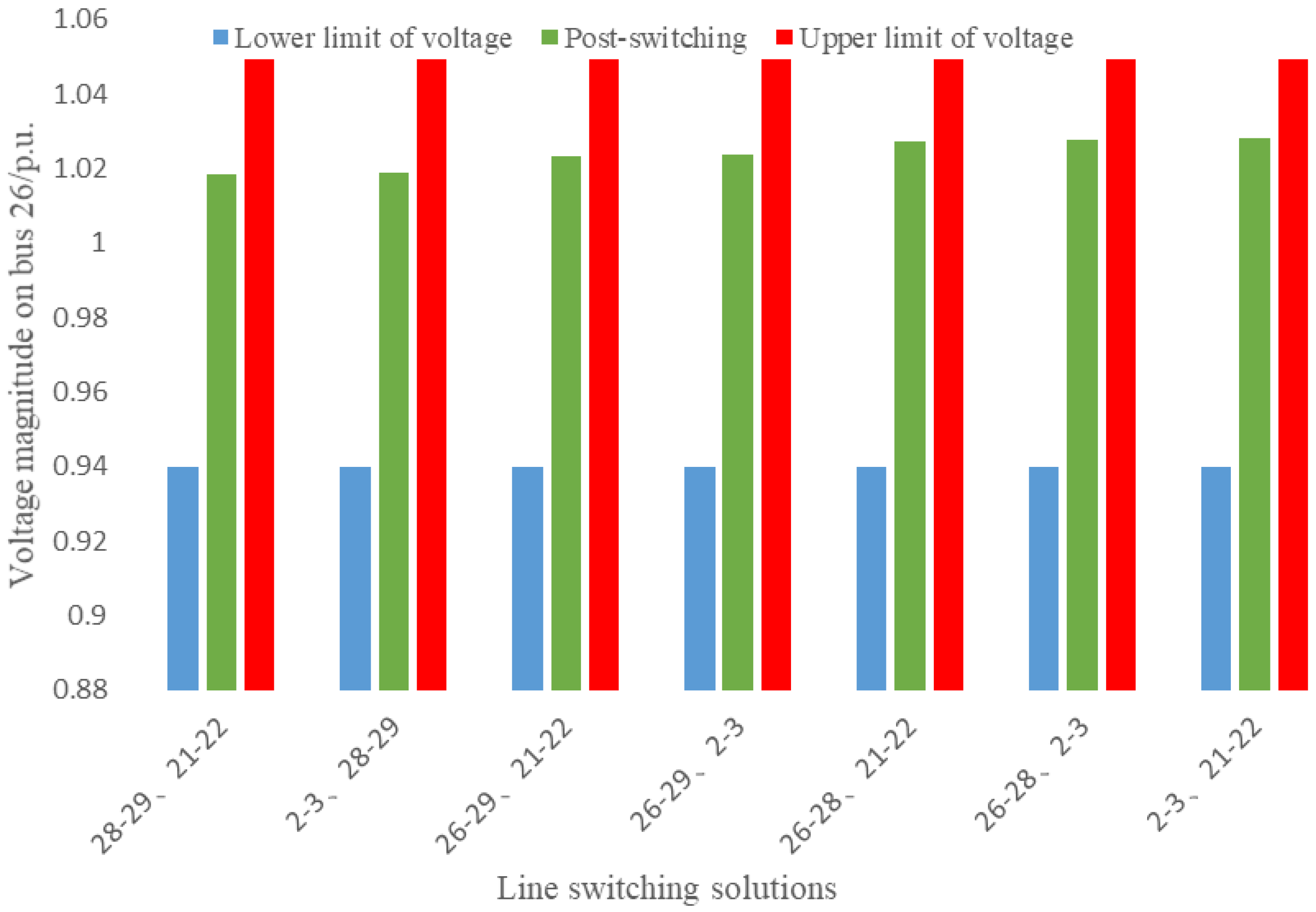
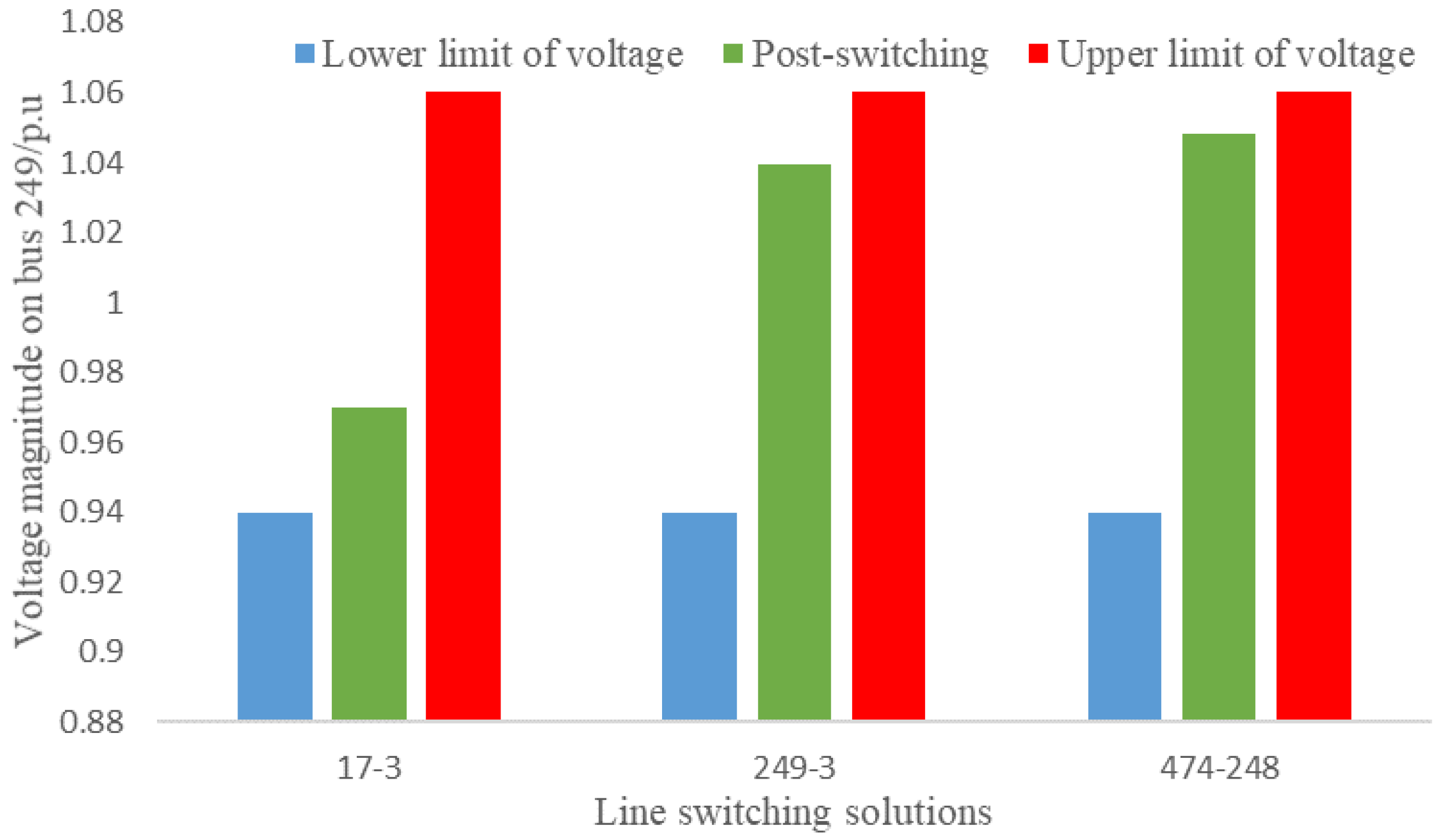
| Stage 1 Screening | Stage 2 Ranking | Stage 3 Detailed Analysis and Assessment | ||||||
|---|---|---|---|---|---|---|---|---|
| Effective Candidates | Highly Ranked Candidates | ΔV26 | Error | Top Candidates | NAM | V26/p.u. | ||
| 2–3 | 5–6 | 8–9 | 26–29 | −0.0109 | −0.0019 | 28–29 | 1.6009 | 1.0326 |
| 3–4 | 7–8 | 21–22 | 26–28 | −0.0062 | −0.0028 | 26–29 | 1.2197 | 1.0366 |
| 4–14 | 6–7 | 16–21 | 26–27 | −0.0022 | 0.0268 | 26–28 | 0.8576 | 1.0404 |
| 6–11 | 16–24 | 28–29 | 2–3 | −0.0010 | −0.0068 | 21–22 | 0.7623 | 1.0414 |
| 17–18 | 22–23 | 4–5 | 28–29 | −0.0008 | −0.0160 | 2–3 | 0.7433 | 1.0416 |
| 10–11 | 26–27 | 26–29 | 16–21 | −0.0007 | 0.0010 | / | ||
| 5–8 | 26–28 | / | 21–22 | −0.0006 | −0.0074 | |||
| The Proposed Methodology | AC Power Flow | Speed-Up | |||
|---|---|---|---|---|---|
| Stage 1 | Stage 2 | Stage 3 | Total | ||
| 0.0007 | 0.0026 | 0.1021 | 0.1054 | 0.9766 | 826.57% |
| Stage 1 Screening | Stage 2 Ranking | Stage 3 Detailed Analysis and Assessment | ||||||
|---|---|---|---|---|---|---|---|---|
| Effective Candidates | Highly Ranked Candidates | ΔV26 | Error | Top Candidates | NAM | V26/p.u. | ||
| 2–3 | 5–6 | 8–9 | 28–29, 21–22 | −0.0317 | −0.0025 | 28–29, 21–22 | 2.9541 | 1.0184 |
| 3–4 | 7–8 | 21–22 | 2–3, 28–29 | −0.0315 | −0.0021 | 2–3, 28–29 | 2.8969 | 1.0190 |
| 4–14 | 6–7 | 16–21 | 26–29, 21–22 | −0.0272 | −0.0021 | 26–29, 21–22 | 2.4871 | 1.0233 |
| 6–11 | 16–24 | 28–29 | 26–28, 21–22 | −0.0216 | −0.0037 | 26–29, 2–3 | 2.4490 | 1.0237 |
| 17–18 | 22–23 | 4–5 | 26–28, 2–3 | −0.0197 | −0.0053 | 26–28, 21–22 | 2.1060 | 1.0273 |
| 10–11 | 26–27 | 26–29 | 26–29, 2–3 | −0.0181 | −0.0108 | 26–28, 2–3 | 2.0774 | 1.0276 |
| 5–8 | 26–28 | / | 2–3, 21–22 | −0.0159 | −0.0086 | 2–3, 21–22 | 2.0297 | 1.0281 |
| The Proposed Methodology | AC Power Flow | Speed-Up | |||
|---|---|---|---|---|---|
| Stage 1 | Stage 2 | Stage 3 | Total | ||
| 0.0007 | 0.0047 | 0.1318 | 0.1372 | 7.3152 | 5231.78% |
| Stage 1 Screening | Stage 2 Ranking | Stage 3 Detailed Analysis and Assessment | ||||
|---|---|---|---|---|---|---|
| Effective Candidates | Highly Ranked Candidates | Top Candidates | NAM | V249/p.u. | ||
| 7–8 | 350–287 | 249–247 | 17–3 | 17–3 | 3.2128 | 0.9702 |
| 7–17 | 2588–2460 | 471–437 | 249–3 | 249–3 | 1.9623 | 1.0392 |
| 17–3 | 287–218 | 474–210 | 474–210 | 474–248 | 1.1226 | 1.0481 |
| 249–3 | 370–286 | 2714–2604 | 474–248 | / | ||
| 25–192 | 374–247 | 2460–2714 | 471–210 | |||
| 383–370 | 474–248 | 513–278 | 249–247 | |||
| 374–270 | 471–210 | 553–299 | 374–247 | |||
| The Proposed Methodology | AC Power Flow | Speed-Up | |||
|---|---|---|---|---|---|
| Stage 1 | Stage 2 | Stage 3 | Total | ||
| 0.1969 | 0.8592 | 1.2532 | 2.3093 | 231.0528 | 9905.32% |
© 2019 by the authors. Licensee MDPI, Basel, Switzerland. This article is an open access article distributed under the terms and conditions of the Creative Commons Attribution (CC BY) license (http://creativecommons.org/licenses/by/4.0/).
Share and Cite
Shen, Z.; Tang, Y.; Yi, J.; Chen, C.; Zhao, B.; Zhang, G. Corrective Control by Line Switching for Relieving Voltage Violations Based on A Three-Stage Methodology. Energies 2019, 12, 1206. https://doi.org/10.3390/en12071206
Shen Z, Tang Y, Yi J, Chen C, Zhao B, Zhang G. Corrective Control by Line Switching for Relieving Voltage Violations Based on A Three-Stage Methodology. Energies. 2019; 12(7):1206. https://doi.org/10.3390/en12071206
Chicago/Turabian StyleShen, Zhengwei, Yong Tang, Jun Yi, Changsheng Chen, Bing Zhao, and Guangru Zhang. 2019. "Corrective Control by Line Switching for Relieving Voltage Violations Based on A Three-Stage Methodology" Energies 12, no. 7: 1206. https://doi.org/10.3390/en12071206
APA StyleShen, Z., Tang, Y., Yi, J., Chen, C., Zhao, B., & Zhang, G. (2019). Corrective Control by Line Switching for Relieving Voltage Violations Based on A Three-Stage Methodology. Energies, 12(7), 1206. https://doi.org/10.3390/en12071206





